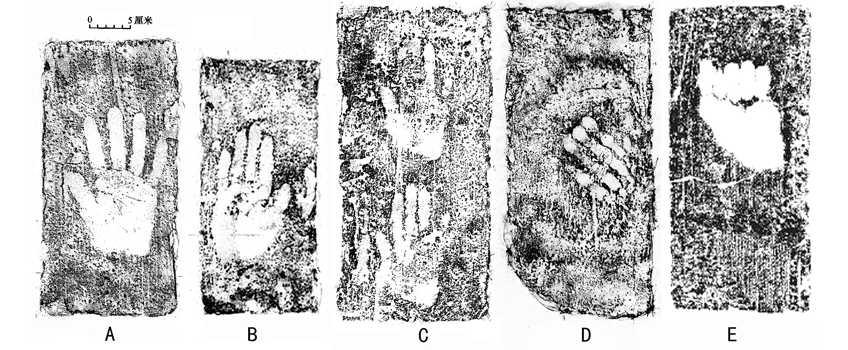

Basic physical characteristics of potters indicated by the handprints on surface of tomb bricks from the Eastern Han Dynasty to the Southern Dynasty in Guangxi and Guangdong provinces
Received date: 2020-09-02
Online published: 2021-04-09
Handprint on the surface of tomb brick is a special printed image consciously left by potters when they made and produced bricks, which is a particular cultural phenomenon. Research of modern forensic medicine, dactylography and trace inspection has indicated that the handprint is closely related to the basic physical characteristics of humans. Using the basis methods of these disciplines, we also can deduce the basic physical characteristics of ancient people. By measuring and analyzing the handprints on tomb bricks from the Eastern Han dynasty and the Southern dynasty in Guangxi and Guangdong provinces, we can discuss the sexual, age, handedness, stature, body weight and somatotype of ancient potters. It was indicated that most potters were young and middle-aged men and a few juveniles and females were also present. And most of potters were of medium height and a little short, which is slightly different from modern people in Guangxi and Guangdong provinces. This study provides a new perspective to understand the ancient potters` group structure characteristics and the ancient handicraft industry in Southern China.

Key words: Bricks; Hand-printed; Physical; Eastern Han; Southern Dynasty
Xuan WEI , Junjie YUAN . Basic physical characteristics of potters indicated by the handprints on surface of tomb bricks from the Eastern Han Dynasty to the Southern Dynasty in Guangxi and Guangdong provinces[J]. Acta Anthropologica Sinica, 2022 , 41(01) : 23 -35 . DOI: 10.16359/j.1000-3193/AAS.2021.0002
| [1] | 广东省文物考古研究所, 广州市番禺区文化局. 番禺汉墓[M]. 北京: 科学出版社, 2006: 185-186 |
| [2] | 吴汝康. 今人类学[M]. 合肥: 安徽科学技术出版社, 1991: 158 |
| [3] | 南京市博物馆, 雨花台区文化广播电视局. 南京市雨花台区宁丹路东晋墓发掘简报[J]. 东南文化, 2014(6): 29-42+65-67 |
| [4] | 韦璇. 两广地区汉晋时期出土手印纹砖的体质人类学分析[D]. 桂林:广西师范大学, 2017 |
| [5] | 邵象清. 人体测量手册[M]. 上海: 上海辞书出版社, 1985 |
| [6] | 席焕久, 陈昭. 人体测量方法[M]. 北京: 科学出版社, 2010 |
| [7] | 日本人类工效学会人体测量编委会编. 人体测量手册[Z]. 北京: 中国标准出版社, 1983 |
| [8] | 何光箎, 钟世旗, 刘正津. 手的活体测量[J]. 解剖学报, 1966, 9(2): 154-162 |
| [9] | 李英宏, 郎俊彦, 白彬. 四川广元、绵阳出土汉代画像砖掌印纹的痕检学分析[J]. 考古与文物, 2007(3): 64-75 |
| [10] | 刘少聪. 新指纹学[M]. 合肥: 安徽人民出版社, 1984 |
| [11] | 王俊. 中国古代赋税[M]. 北京: 中国商业出版社, 2015: 56 |
| [12] | 王子今. 两汉社会的“小男”“小女”[J]. 清华大学学报(哲学社会科学版), 2008(1): 39-45 |
| [13] | 陈献跃. 根据人体的手部数据推断性别的研究[J]. 数理统计与管理, 2003(A1): 28-30 |
| [14] | 沈德立. 脑功能开发的理论与实践[M]. 北京: 教育科学出版社, 2001: 117 |
| [15] | 陈献跃. 利用人的手部数据推断身高的研究[J]. 数理统计与管理, 2004(1): 35-36 |
| [16] | 李力. 回归法推断手印和足迹与身高和体重的关系[J]. 法医学杂志, 2005, 21(4): 252-254 |
| [17] | 彭卫, 杨振红. 中国风俗通史·秦汉卷[M]. 上海: 上海文艺出版社, 2002: 354 |
| [18] | 【西汉】司马迁. 史记·卷一百四·田叔列传[M]. 北京:中华书局, 2006: 601-604 |
| [19] | 翦伯赞. 两汉时期的雇佣劳动[J]. 北京大学学报, 1959(1): 53-60 |
| [20] | 【南朝宋】范晔. 后汉书·卷四十四·胡广列传[M]. 北京:中华书局, 1965: 421-424 |
| [21] | 【东汉】班固. 汉书·卷七十六[M]. 北京:中华书局, 2005: 2409 |
| [22] | 顾丽华. 汉代妇女生活情态研究[M]. 北京: 社会科学文献出版社, 2012: 148 |
| [23] | 【清】朱彬撰. 礼记训纂·卷十二[M]. 北京:中华书局, 1996: 434 |
| [24] | 赵东玉. 西周春秋妇女地位的式微——中国妇女地位变迁史研究之一[J]. 吉林大学社会科学学报, 1987(04): 36-39 |
| [25] | 王翠艳. 左利手及其形成机制:生理、病理及心理学的视角[J]. 心理学探新, 2012, 32(3): 272-276 |
| [26] | 张霭珠, 陈力君. 定量分析方法[G]. 上海: 复旦大学出版社, 2003 |
| [27] | 李济. 中国民族的形成[M]. 上海: 上海人民出版社, 2008: 39-40 |
| [28] | 广东省体育局. 2005年广东省国民体质监测报告[M]. 广州: 广东科技出版社, 2008: 90 |
| [29] | 广西壮族自治区体育局群体处, 广西国民体质监测中心. 2005年广西国民体质监测报告[G]. 南宁: 广西人民出版社, 2007: 26 |
/
| 〈 |
|
〉 |